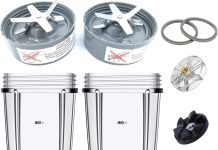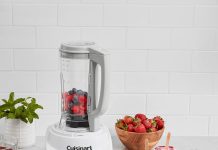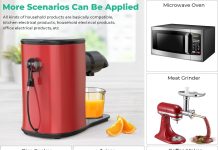Blenders have become an indispensable part of our modern kitchens, allowing us to effortlessly whip up delicious smoothies, soups, and dips in a matter of seconds. However, in the hustle and bustle of our daily lives, we might overlook an important question: are there safety features in blenders? As we explore this topic, we’ll uncover the hidden mechanisms that manufacturers have incorporated into blenders to ensure our safety while using these powerful appliances. So, let’s dive in and discover the fascinating world of blender safety!
Review contents
Types of Safety Features
Blenders are an essential kitchen appliance that helps us blend and mix ingredients seamlessly. However, their powerful motors and sharp blades can present certain safety concerns. To mitigate these risks, manufacturers have incorporated various safety features into blenders. These safety features not only protect users from potential accidents but also enhance the overall usability and reliability of the appliance. In this article, we will explore the different types of safety features commonly found in blenders and discuss their effectiveness.
1.1 Overload Protection
Blenders often come equipped with overload protection mechanisms to prevent excessive strain on the motor and ensure its longevity. These safety features detect when the blender is being overloaded with ingredients and take appropriate action to prevent overheating and motor burnout.
1.2 Interlocking System
Another crucial safety feature in blenders is the interlocking system. This system ensures that the blender can only operate when all parts, such as the lid, container, and blades, are properly secured. This prevents any accidental spills, leaks, or injuries that may occur if the blender is not assembled correctly.
1.3 Anti-Slip Base
Blenders generate significant vibrations during operation, which can cause them to move around or even tip over. To address this issue, many blenders feature an anti-slip base. These bases are often made of rubberized material or have adhesive feet to provide better grip on the countertop or surface, ensuring stability and preventing accidents.
1.4 Leak-Proof Design
A leak-proof design is a crucial safety feature in blenders, especially when dealing with liquids or ingredients prone to splattering. It ensures that the blender jar has a tight seal, preventing any leakage during operation and minimizing the risk of spills and messes.
1.5 Safety Locking Mechanism
Safety locking mechanisms offer an additional layer of protection by preventing the blender from starting accidentally or while it is being handled incorrectly. These mechanisms usually involve locks on the blade assembly, lid, or power button, ensuring that the blender can only be activated when all components are properly aligned and secured.
Overload Protection
2.1 Sensing Mechanism
Most blenders with overload protection feature a sensing mechanism that can detect when the motor is being overloaded. This mechanism monitors factors such as motor speed, temperature, and current draw to determine if the blender is operating within safe limits.
2.2 Automatic Shutdown
When an overload is detected, blenders equipped with overload protection will automatically shut down to prevent any further damage to the motor or other components. This feature not only protects the blender but also ensures the safety of the user by preventing any potential hazards associated with a malfunctioning appliance.
2.3 Motor Durability
Overload protection features not only protect the motor from damage but also enhance its overall durability. By preventing excessive strain, these safety measures extend the lifespan of the motor, ensuring reliable and long-term performance.
Interlocking System
3.1 Blade Locking Feature
One of the essential aspects of the interlocking system is the blade locking feature. This feature ensures that the blades can only be engaged when the blender jar’s lid is securely in place. This prevents any accidental contact or injuries that may occur if the blades are exposed during operation.
3.2 Lid Locking Mechanism
Blenders with a lid locking mechanism ensure that the lid stays securely in place during operation. This prevents any splattering or leaks, maintaining a safe environment in the kitchen and minimizing the risk of accidents caused by hot liquids or sharp blades.
3.3 Power Supply Control
Some blenders incorporate a power supply control mechanism as part of their interlocking system. This feature ensures that the blender can only be powered on when all components are properly assembled and secured. It adds an extra layer of safety by preventing the blender from accidentally turning on when it is not in use or when not properly assembled.
3.4 Tamper Detection
In addition to blade and lid locks, some blenders are equipped with tamper detection mechanisms. These safety features can detect if any foreign objects, such as spoons or utensils, are accidentally introduced into the blender while it is in operation. When such an object is detected, the blender automatically shuts down to prevent any damage or injuries caused by the foreign material.
Anti-Slip Base
4.1 Rubberized Feet
Blenders feature anti-slip bases with rubberized feet to ensure stability during operation. The rubberized feet create friction between the blender and the countertop or surface, effectively preventing it from sliding or tipping over. This safety feature is particularly important when handling heavy ingredients or operating the blender at high speeds.
4.2 Adhesive Material
Some blenders are designed with adhesive materials on the base, providing even more stability and preventing any movement during operation. These adhesive materials create a strong bond with the countertop, significantly reducing the risk of accidents or injuries caused by a blender that is not securely positioned.
4.3 Stability Enhancements
Beyond rubberized feet and adhesive materials, blenders may incorporate other stability enhancements, such as wider bases or additional weight in the lower parts. These design elements further increase the blender’s stability, minimizing the likelihood of accidents and creating a safer environment for users.
Leak-Proof Design
5.1 Tight Seal
A leak-proof design is vital in blenders when dealing with liquids or ingredients that tend to splash or spill. Blenders with a tight seal between the jar and the lid prevent any leakage during operation, ensuring that the ingredients, especially hot liquids, stay contained within the blender. This significantly reduces the risk of burns or accidents caused by spills.
5.2 Durable Jar Material
In addition to a tight seal, blenders with a leak-proof design often utilize durable jar materials, such as high-quality plastic or glass. These materials are resistant to cracking, chipping, or shattering, making them safe to use even at high speeds or with hot liquids. A blender jar with excellent durability contributes to a safer cooking experience.
5.3 Spill-Proof Lid
Alongside a tight seal, some blenders feature spill-proof lids that prevent any liquid or ingredients from escaping the blending container, even when the blender is tilted or in motion. This additional safety measure ensures that no spills occur while pouring or transferring blended mixtures.
Safety Locking Mechanism
6.1 Blade Assembly Lock
The blade assembly lock is a safety feature that prevents the blades from rotating while the blender is not in use or during cleaning. This feature ensures that accidental contact with the blades is avoided, reducing the risk of injuries. Users can remove the blade assembly securely and clean it without worrying about accidental engagement.
6.2 Lid Lock
The lid lock is an important safety mechanism that ensures the blender cannot be operated without the lid securely in place. This prevents any splattering or accidental spills that may occur if the lid is not correctly positioned during operation. The lid lock provides peace of mind to users, knowing that the blender will not start until it is deemed safe to do so.
6.3 Power Button Lock
Some blenders incorporate a power button lock to prevent accidental or unauthorized use of the appliance. This lock ensures that the blender cannot be turned on or operated without deliberate activation, adding an extra layer of safety, especially in households with children or pets.
Additional Safety Features
7.1 Cord Storage
Blenders may include cord storage features to keep the power cord neatly organized when not in use. This helps prevent tripping hazards and keeps the countertop or storage area clutter-free, promoting a safe kitchen environment.
7.2 Non-Toxic Materials
Safety-conscious blender manufacturers prioritize using non-toxic materials for constructing blender parts, such as food-grade plastics or stainless steel. This ensures that no harmful substances or chemicals are transferred to the food or liquids being blended, making the appliance safe for consumption.
7.3 Anti-Overheating
Some blenders come equipped with anti-overheating features that automatically shut down the motor if it exceeds a certain temperature. This protects both the blender and the user from potential hazards caused by overheating components. The anti-overheating mechanism not only ensures the longevity of the appliance but also prevents any safety risks associated with temperature extremes.
7.4 Child Safety Lock
Blenders designed with a child safety lock feature help prevent any accidental or unauthorized usage by children. This safety measure adds an extra layer of protection, ensuring that the blender cannot be operated without adult supervision. This feature is particularly beneficial for families with young children, providing parents with peace of mind.
7.5 Warning Indicators
Modern blenders often incorporate warning indicators, such as lights or alarms, to alert users of potential risks or malfunctions. These indicators can signal issues like overload, improper assembly, or overheating, allowing users to take appropriate action and prevent accidents.
Maintenance and Safe Usage Tips
8.1 Cleaning Instructions
To ensure the longevity and safety of the blender, it is essential to follow proper cleaning instructions. Most blenders have removable parts that can be safely washed by hand or in a dishwasher. It is crucial to disassemble the blender and clean each component thoroughly, paying close attention to hard-to-reach areas around the blade assembly. Avoid submerging the motor base in water and always refer to the manufacturer’s cleaning guidelines.
8.2 Proper Assembly
Before using a blender, it is important to properly assemble all components, ensuring that the blade, lid, and container are securely placed. This will activate the interlocking system and allow the blender to function safely. Checking the assembly before every use reduces the risk of accidents and ensures optimal performance.
8.3 Overheating Prevention
To prevent overheating, it is advisable to use the blender in shorter intervals rather than running it continuously for extended periods. Most blenders have recommended usage times outlined in their manuals, which should be followed to avoid overheating the motor. Additionally, blending hot liquids should be done with caution, starting at a slow speed and gradually increasing if necessary.
8.4 Safe Voltage Usage
When using a blender, it is important to ensure that the power supply voltage matches the blender’s specifications. Using a blender with a higher or lower voltage than recommended can lead to malfunctioning or overheating. Always consult the user manual or contact the manufacturer for guidance on safe voltage usage.
Are Safety Features in Blenders Reliable?
9.1 Quality Assurance
Blender manufacturers rigorously test their products to ensure the reliability and effectiveness of the safety features. These tests involve evaluating the performance, durability, and safety of the blenders under various conditions. Manufacturers adhere to strict quality assurance procedures and standards to guarantee that the safety features are robust and will provide reliable protection to users.
9.2 User Reviews
User reviews serve as valuable resources to gauge the reliability of the safety features in blenders. By reading about real experiences and feedback from users, potential buyers can get insights into the performance and effectiveness of the safety features. Positive user reviews that highlight the durability and effectiveness of the safety features can provide confidence in the reliability of the blender.
9.3 Certification Standards
Blenders that meet specific certification standards, such as UL (Underwriters Laboratories) certification, have been tested and verified for safety. These certifications ensure that the blender complies with stringent safety requirements and has undergone rigorous testing processes. Buyers can look for certification seals on blender packaging as an indication of their adherence to recognized safety standards.
Conclusion
Blenders equipped with various safety features offer users peace of mind while using this essential kitchen appliance. Overload protection mechanisms, interlocking systems, anti-slip bases, leak-proof designs, safety locking mechanisms, and additional safety features collectively enhance the usability, reliability, and safety of blenders. However, it is important for users to follow maintenance and safe usage tips to ensure the effectiveness of these safety features. By understanding the different safety features available and their reliability through techniques like quality assurance, user reviews, and certification standards, consumers can make informed decisions when selecting a blender that prioritizes their safety.































